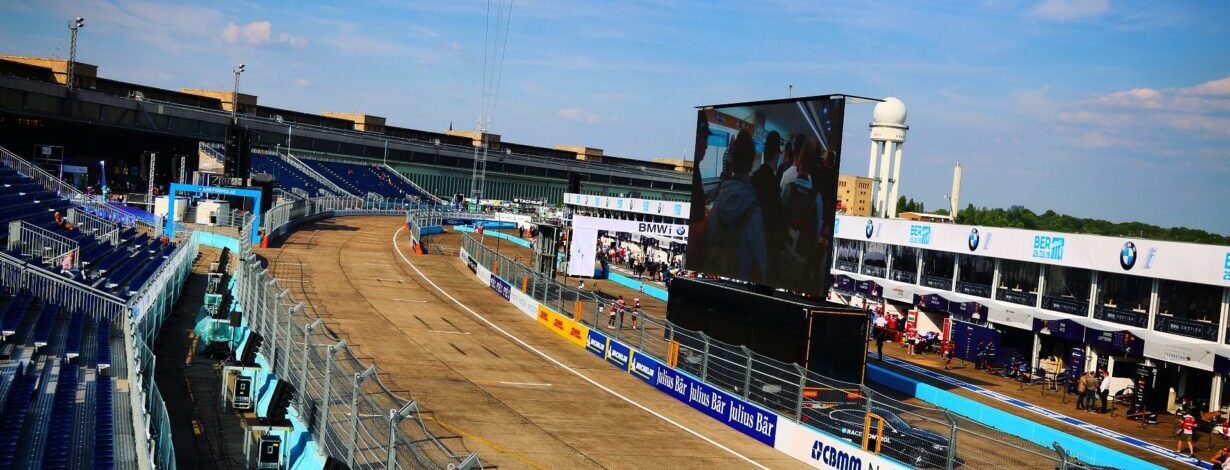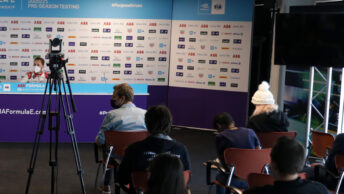Formula E was five races into its 2019-2020 season when the global coronavirus pandemic threw a five-month-long spanner into the works. Today, the series has announced it will finish off the disrupted championship with six back-to-back races over just nine days in August, at the Berlin Tempelhof site.
The new calendar:
The races will happen over a rammed, nine-day schedule in early August. Formula E’s last race was in Marrakech, on February 29th and the first Berlin race is scheduled for August 5th.
All the races will run as double-headers, with two races happening over two days, followed by a one-day break, then another double-header, followed by two break days and the final doubleheader.
- August 5-6: Berlin rounds 1 & 2
- August 8-9: Berlin rounds3 & 4
- August 12-13: Berlin rounds 5 & 6
This will take the season to 11 races and fulfil the requirement for two more events (either double or single header) in order to award a championship. So by August 13th, we should know who the new teams’ and drivers’ titleholders are.
Because there have only been five races so far in the season, compared to six in Berlin, a team that comes in and does well here could completely turn around the championship over the frantic course of those nine days. So although it looked as though DS Techeetah, Jaguar and BMWi Andretti were the frontrunners at the point when we paused the season, there is absolutely everything to play for on Tempelhof’s concrete.
Why are all the races in Berlin?
The short version is: because this is the most guaranteed way to make sure they go ahead.
Although Formula One has announced a partial, yet-to-be-fully-confirmed international calendar post-lockdown, Formula E is in a different position. Midway through the 2019-20 season, there’s pressure to finish it before the 2020-21 season starts, from October this year.
With very little time left to do that, Formula E had to find a way to run enough events, without taking risks of any being cancelled. The easiest way to ensure that is running them at Tempelhof – a secure site, being a former airport, that has enough space to be able to run multiple track configurations and also to spread out garages and facilities enough to ensure social distancing.
Working with the German authorities, Formula E has found a way of operating with fewer than 1000 people on-site, from site build to race days to tear-down, which means that even if strict lockdown returns the events should be able to go ahead.
Additionally, as 72% of Formula E’s CO2 emissions are due to freighting equipment and cars between races and a further 14% are from staff travel to the events, running the races in quick succession at the same facility prevents unnecessary carbon emissions in ending a season that was never going to be able to play out as it had been intended. Given the purpose of travelling to races is to reach people, it makes sense to hold closed-door racing without incurring those carbon costs.
Nine days, six races, three tracks, two metres
It’s a lot to fit in – Formula E’s CEO Jamie Reigle has called the week-and-a-bit a “festival” but it probably won’t have much of that atmosphere. Aside from being a pretty gruelling slog for the teams, in-between curfews and zoning restrictions, they have a lot of extra measures to deal with to make sure racing can happen.
Teams will have to work closely, using extra PPE (personal protective equipment – the face screens and gloves you will have seen medical staff wearing) and everyone on-site has to wear a surgical mask at all times.
As well as that, ‘zones’ will be established to keep groups of people apart. From local suppliers to teams
This might all sound a bit extreme, compared to the relatively relaxed approach some other championships have taken but Formula E says it’s taking the precautions based on what the risk is, especially given it would compromise the series to finish a season racing on non-city, permanent circuits.
“Since taking action to suspend our season in March, we have emphasised a revised calendar which places the health and safety of our community first, represents Formula E’s distinct brand of city-centre racing and offers an exciting conclusion to the compelling season of racing we had seen so far.
Jamie Reigle, ABB Formula E CEO
The good news is, the races won’t all be happening on the same circuit. Tempelhof is a flexible space, with the Formula E circuit built on the expanse of the old runway so it’s relatively easy to get different track layouts homologated and set up to be used.
Each double-header will take place on a different circuit layout, with the full details yet to be confirmed. Tempelhof is often a bit of a spoke in the works for Formula E teams, as the surface is very different to some of the other tracks and a shifting layout will make a real challenge as to who can come up with the best setup and strategy with very little time to change anything after the teams first arrive.
It might sound like a lot, to rearrange the track in just one or even two days of downtime but without crowds or grandstands the logistics become quite a lot simpler; if Formula E keep the pit lane and other zoning-restricted areas similar then they should be easily able to. The circuits are designed to be put together and taken down very quickly, even if they’ve never quite been put through these paces before.
There’s some discussion that the midweek races, on the 8th and 9th of August, might even be held at dusk or under lights to make the surface and track even less predictable. Than normal Formula E, that is.
On-site restrictions
Like all motorsport series that have come back to racing after the lockdown, including NASCAR and Indycar, Formula E will be racing “behind closed doors.”
Only 1000 people will be allowed into the site at any one time, including marshals, medical staff, teams and operational staff for Formula E. All staff with roles that can be done remotely – from Formula E’s own communications and press team to, potentially, team bosses, will not be on-site.
Teams had asked, given the schedule of the races, for the maximum garage personnel to be increased from 20 to 25. However, to ensure the numbers were kept low enough the request was denied.
The staff and crew for the I-Pace eTrophy races planned will come from the same 1000 person allocation, with strict zoning keeping the crews apart.
TV and media coverage
The good news is: Formula E will be filming and broadcasting the races. There won’t be as many people from TV crews on-site, to adhere to the numbers limit but there will be a broadcast and interviews that you can watch from home.
Other media, like journalists or non-championship photographers, will not be on-site at all but Formula E have said there will be some sort of electronic alternative, whether that’s press conferences or direct interview opportunities. Only six photographers, for teams and Formula E, will be allowed to work on-site.
For a lot of us, it’s a very tricky situation to accept but Formula E had a choice to make sure the racing was safe and could definitely take place and this is the most sensible thing to do. Not including media makes zoning and logistics easier and keeping track of Formula E’s own personnel and teams is much easier than a broader group.
Testing and medical precautions
Formula E has published additional guidelines for the Tempelhof events that include some pretty rigorous coronavirus testing procedures for everyone on-site.
They say people over 60 should not attend the races (due to their higher risk from COVID-19) and that accreditation for someone to attend as team or logistics staff will be closely examined.
Everyone will also be tested for symptoms (via a daily wellness questionnaire and temperature check) and a PCR test before they enter the site, renewed every 5 days. PCR tests are the swab check you might have seen that looks for the COVID-19 viral “DNA,” to show an active infection. It’s not much fun but it is an important check, with people coming in to work on the site.
Here’s golfer Ian Poulter undergoing a PCR check:





